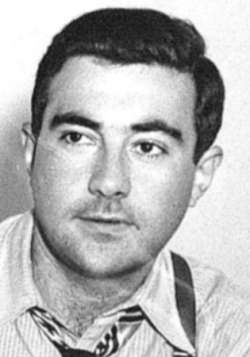Ed here: This is a very long piece on the actors and director of The Brasher Dubloon. A real piece of Hwood history that I enjoyed.
Posted by Moira Finnie on February
18, 2009 FROM MOVIE MORLOCKS
“How I hate the summer
winds. They come in suddenly off the Mojave Desert, and you can taste the sand
for days.”
This is the promising voice-over one hears at the
beginning of what may be the least known cinematic adaptation of one of Raymond
Chandler‘s Philip Marlowe stories. Made into a Michael Shayne
mystery starring Lloyd Nolan in 1942′s Time To Kill, the author,
still peeved at his story’s treatment in that decent, if workmanlike
version and further miffed that he had no more income from any other movies
made by the studio that owned the rights to the story, 20th Century Fox
reportedly hoped to cash in on the ‘craze’ for crime stories set in the still
exotic environs of a dark tinted Los Angeles following the great
popularity of such films as Murder, My Sweet and The Big Sleep.
George Montgomery, at 30, was one of the youngest actors cast to play the character in
the movies, is seen in this opening scene approaching an ominously
photographed mansion buffeted by the dry, swirling Santa Ana winds pushing
the gnarled trees that surround the house against the walls. As he approaches
the door, a sylph-like figure admits him into the house, swallowing him up in
the same way that this movie seems to have been subsumed in a cinematic vault.
Never having been issued commercially on
dvd and only broadcast rarely to the best of my knowledge, I was
eager to see this movie when a friend recently lent it to me. In this case, The
High Window, Chandler‘s third novel, published in 1942, was
fashioned by the stylish director John Brahm and his scenarists Dorothy
Bennett and Leonard Praskins into a 72 minute dash through various
film noir motifs and presented to a waiting public in the form of 20th Century
Fox’s The Brasher Doubloon (1947). You have some of the same atmospheric
elements of the other popular movies made from Chandler‘s novels in that
period. Actually, after watching this movie recently, I started to wonder
if the filmmakers at 20th Century Fox got together around this time to put
together a film noir kit with ingredients that should have resulted in a
memorable classic. Perhaps this hypothetical film noir kit might have been
planned out neatly at a few production meetings that might have gone something
like this…
The filmmakers knew that
the following items were needed:
1.) A Detective to play Philip Marlowe
Check
In retrospect, I admit that I’ve grown to like
the callow George Montgomery‘s breezy style. After growing up seeing
this skilled cabinet maker hawk wood polish on the tube, it was news to me
that he was also an actor with a once-viable career.
Today, as my ongoing cinematic education
continues, I’ve begun to enjoy his appearances. The musical delights and
petty conflicts of Orchestra Wives (1942), the wartime romance
and campiness of China Girl (1942), and Montgomery‘s ironic
and funny turn in Roxie Hart (1942), as well as the many Westerns
the Montana native made, have taught me that he was much more than singer Dinah
Shore‘s ex-husband. Before being seduced into a Hollywood sojourn, his
first career choice had been as an interior designer, an artistic path he later
happily returned to with considerable success as he became a well known
sculptor as well as craftsman.
Still, he was a strapping 6 feet plus presence and
he had a good baritone–which is used particularly well for the voice-overs that
are sprinkled throughout the narrative of this movie–but I must confess that I
had moments of longing for the gravitas, the curdled romanticism and a
certain ragged gallantry that the much older Dick Powell and Humphrey
Bogart brought to the part of gumshoe Philip Marlowe so effortlessly.
Of course, this may be because they were the first Marlowes I knew. In Raymond
Chandler‘s books, his creation is described as “slightly over six feet tall
and weighs about 190 pounds” with an insubordinate air. The writer also
mentioned once that “I think [Marlowe] might seduce a duchess, and I am quite
sure he would not spoil a virgin.” This iconoclastic knight errant with a
personal sense of honor and a fresh mouth does find expression in Montgomery‘s
tender efforts at seducing the skittish girl in this story, but he never quite
inhabits the role for me.
for the ret go here:
http://moviemorlocks.com/2009/02/18/the-legendary-brasher-doubloon-1947/#more-7462






